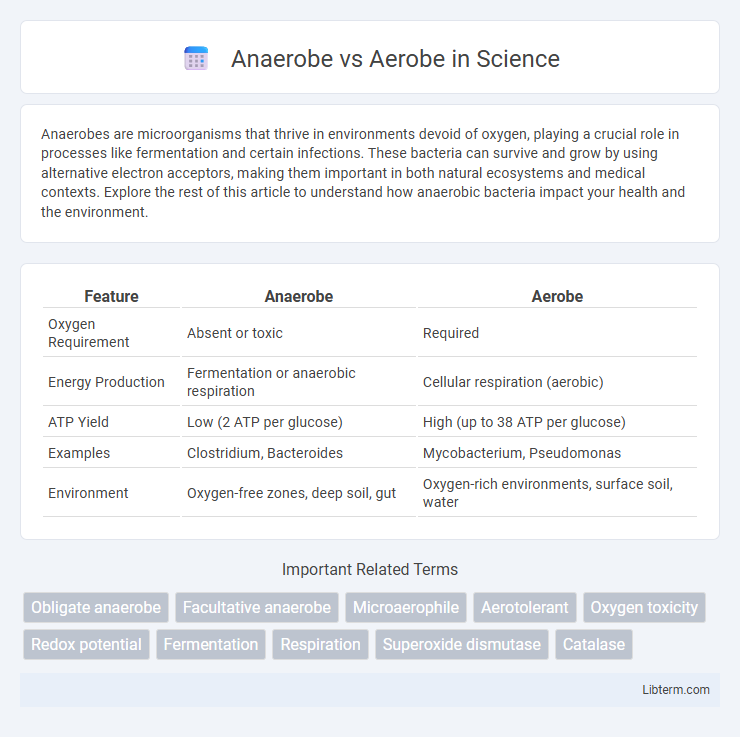Anaerobes are microorganisms that thrive in environments devoid of oxygen, playing a crucial role in processes like fermentation and certain infections. These bacteria can survive and grow by using alternative electron acceptors, making them important in both natural ecosystems and medical contexts. Explore the rest of this article to understand how anaerobic bacteria impact your health and the environment.
Table of Comparison
| Feature | Anaerobe | Aerobe |
|---|---|---|
| Oxygen Requirement | Absent or toxic | Required |
| Energy Production | Fermentation or anaerobic respiration | Cellular respiration (aerobic) |
| ATP Yield | Low (2 ATP per glucose) | High (up to 38 ATP per glucose) |
| Examples | Clostridium, Bacteroides | Mycobacterium, Pseudomonas |
| Environment | Oxygen-free zones, deep soil, gut | Oxygen-rich environments, surface soil, water |
Introduction to Anaerobes and Aerobes
Anaerobes are microorganisms that thrive in environments devoid of oxygen, utilizing fermentation or anaerobic respiration for energy production. Aerobes require oxygen to survive and generate energy through aerobic respiration, relying on oxygen as the final electron acceptor in their metabolic processes. Understanding the distinction between anaerobes and aerobes is crucial in fields such as microbiology, medicine, and environmental science due to their varied metabolic pathways and ecological roles.
Definition of Anaerobic and Aerobic Organisms
Anaerobic organisms are microorganisms that thrive in environments devoid of oxygen, utilizing fermentation or anaerobic respiration to generate energy. Aerobic organisms require oxygen to survive, relying on aerobic respiration where oxygen acts as the final electron acceptor in energy production. These distinct metabolic pathways define the ecological niches and physiological adaptations of anaerobic and aerobic organisms.
Key Differences Between Anaerobes and Aerobes
Anaerobes thrive in environments devoid of oxygen and rely on fermentation or anaerobic respiration for energy production, while aerobes require oxygen for cellular respiration and efficient ATP generation. Anaerobes utilize electron acceptors other than oxygen, such as sulfate or nitrate, whereas aerobes use oxygen as the terminal electron acceptor in the electron transport chain. The presence of enzymes like superoxide dismutase and catalase enables aerobes to neutralize reactive oxygen species, a capability often absent in obligate anaerobes, influencing their tolerance to oxygen exposure.
Oxygen Requirements for Growth
Anaerobes thrive in environments devoid of oxygen, relying on fermentation or anaerobic respiration for energy production. Aerobes require oxygen to grow, using it as the final electron acceptor in aerobic respiration to maximize ATP yield. Facultative anaerobes can switch between aerobic and anaerobic metabolism depending on oxygen availability, demonstrating metabolic flexibility.
Metabolic Pathways: Anaerobic vs. Aerobic Respiration
Anaerobes utilize anaerobic respiration or fermentation pathways to generate ATP without oxygen, relying on electron acceptors such as nitrate, sulfate, or carbon dioxide instead of oxygen. Aerobes depend on aerobic respiration, where oxygen acts as the final electron acceptor in the electron transport chain, resulting in higher ATP yield through oxidative phosphorylation. The metabolic efficiency of aerobic respiration surpasses anaerobic pathways, producing up to 38 ATP molecules per glucose molecule compared to 2 ATP in typical anaerobic fermentation processes.
Examples of Anaerobic and Aerobic Microbes
Clostridium botulinum and Bacteroides fragilis exemplify anaerobic microbes thriving in oxygen-free environments, while aerobic microbes such as Pseudomonas aeruginosa and Mycobacterium tuberculosis require oxygen for survival. Anaerobes often inhabit environments like deep tissues and the gastrointestinal tract, whereas aerobes dominate oxygen-rich habitats including soil and surface waters. Understanding these microbial examples guides research in medical microbiology and environmental biotechnology.
Environmental Niches and Habitats
Anaerobes thrive in oxygen-deprived environments such as deep soil layers, sediments, and the gastrointestinal tracts of animals, where they engage in fermentation or anaerobic respiration. Aerobes require oxygen-rich habitats like surface water, soil layers exposed to air, and animal tissues with high oxygen availability, enabling efficient energy production via aerobic respiration. These distinct environmental niches dictate the metabolic adaptations and ecological roles of anaerobic and aerobic microorganisms.
Importance in Health and Disease
Anaerobes, thriving in oxygen-free environments, play crucial roles in human gut microbiota by aiding digestion and synthesizing vitamins while maintaining immune balance. Aerobes, requiring oxygen, are vital for energy production in cells through oxidative phosphorylation but can also generate reactive oxygen species contributing to oxidative stress and inflammation. Understanding the balance and interaction between anaerobic and aerobic microbes is essential for managing conditions like infections, inflammatory bowel disease, and metabolic disorders.
Industrial and Biotechnological Applications
Anaerobes play a critical role in industrial applications such as biogas production through anaerobic digestion, which converts organic waste into methane-rich fuel. Aerobes are essential in biotechnological processes including wastewater treatment and aerobic fermentation used for producing antibiotics and enzymes. Understanding the distinct metabolic pathways of anaerobic and aerobic microorganisms enhances the efficiency of bioenergy production and bioprocess optimization.
Summary and Future Perspectives
Anaerobes thrive in oxygen-free environments, utilizing fermentation or anaerobic respiration, while aerobes depend on oxygen for energy production through aerobic respiration, impacting their metabolic pathways and ecological niches. Advances in metagenomics and synthetic biology promise enhanced understanding and manipulation of these organisms, with potential applications in bioenergy, medicine, and environmental remediation. Future research aims to optimize anaerobe and aerobe interactions in bioprocessing and develop targeted therapies leveraging their unique metabolic capabilities.
Anaerobe Infographic

 libterm.com
libterm.com